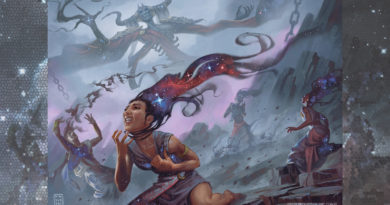Historic Pauper Fan Tournament Preview
Magic Arcanum is about to host its first Fan Tournament, and I spent considerable time looking for deck ideas online. My intent wasn’t to copy a list, per say, but to get a better idea of strategies that might work for our chosen format — Historic Pauper.
Nicole and I picked Historic Pauper for a few reasons: it would be easy for anyone to assemble a deck, being that it has the lowest cost to entry, and even a brand-new Arena account comes with a reasonable collection of common cards.
And second, we both loved playing in the paper pauper leagues when we worked together at TCGplayer. To me, the format captures “real Magic,” in that there are no planeswalkers, no busted rares or mythics, no “must-have” fetch lands to fix your manabases. Each game comes down to the fundamentals; combat, card advantage, and capitalizing on your tempo.
Here are a few of the decks I studied before locking in my final list upon registering for the tournament (which I won’t be revealing here. Sorry!)
Embalming Fluid
2 Underworld Charger
4 Sacred Cat
4 Anointer Priest
2 Loxodon Restorer
4 Omen of the Sun
4 Ill-Gotten Inheritance
4 Village Rites
4 Murder
4 Raise the Alarm
2 Feed the Swarm
2 Call the Cavalry
4 Scoured Barrens
10 Swamp
10 Plains
// Sideboard
4 Light of Hope
2 Moment of Craving
2 Divest
4 Duress
3 Swift Response
This deck wants to fill up the board with cheap token creatures and play defense while waiting for Ill-Gotten Inheritance to drain most of the life out of the opponent.
I figured control strategies would be popular, so the cards from Amonkhet Remastered with the embalm mechanic caught my eye. If your opponent spends a card to kill your creature (or counter it while being cast) you can still embalm it later.
The lifegain package in the deck (Sacred Cat, Anointer Priest, Omen of the Sun, Loxodon Restorer) helps hold off the aggressive red decks as well. Murder is one of the best removal spells in the format, and Village Rites is a great way to cash in one of your soldier tokens (thanks, Raise the Alarm!) and refill your hand.
Overall, I think this deck has a good game plan for matchups against both aggro and control, and the sideboard gives you even more ways to fight against both types of opponents.
A word on sideboarding – for this tournament, the sideboard isn’t required, but I did want to include some general catch-all cards that might be useful in different situations. Since this is the very first tournament, I have no idea what types of decks other players will bring, and that makes it hard to prepare for anything too specific.
Zendikons
4 Leaf Gilder
4 Llanowar Visionary
4 Druid of the Cowl
4 Llanowar Elves
4 Tajuru Blightblade
4 Vastwood Zendikon
4 Nissa’s Zendikon
4 Ranger’s Guile
4 Ram Through
24 Forest
// Sideboard
4 Healer of the Glade
3 Thicket Crasher
4 Return to Nature
4 Plummet
I found this deck on YouTube, on a channel called “Zendikari Animist” appropriately enough. It might be the most straightforward list I’ve seen. You simply use an army of elves to power out either Nissa’s Zendikon or Vastwood Zendikon, both of which hit hard (and fast, thanks to having haste.)
Ram Through serves as your removal, and if you pair it with Tajuru Blightblade, it becomes an instant kill on just about anything.
Against an aggressive opponent, you’ll want to use the Healer of the Glade out of the sideboard to prop up your life total while trading off with goblins and Viashino Pyromancers.
Likewise, Thicket Crasher can help against decks like the Embalming Fluid list shared above – giving your Zendikons trample (they’re elementals) lets them stomp right over a line of token blockers.
While I liked the simplicity of the deck (and you can’t argue with its performance on the YouTube channel) I felt like I wanted something a little flashier for my first entry into the tournament.
Captivating Auras
3 Pious Wayfarer
4 Transcendent Envoy
3 Nexus Wardens
4 Heliod’s Pilgrim
4 Captivating Unicorn
2 Sentinel’s Eyes
2 Angelic Gift
4 Pacifism
4 Setessan Training
3 Candlelight Vigil
3 Karametra’s Blessing
4 Blossoming Sands
14 Plains
6 Forest
// Sideboard
3 Daybreak Chaplain
3 Disenchant
3 Light of Hope
3 Life Goes On
3 Jade Guardian
Theros is one of my favorite planes, and Constellation is such a fun and flavorful mechanic, I couldn’t help but take a closer look at this list created by TheNewDrSpilikin on YouTube.
Rather than stack up a ton of enchantments on a single hexproof threat (like a traditional Bogles pauper list) this one spreads the love around a bit, and uses Transcendent Envoy to reduce the cost of auras like Setessan Training and Angelic Gift.
If you find yourself up against a control deck with a lot of removal, you can bring in Jade Guardian from the sideboard, along with a good mix of other cards found in this color combination.
Captivating Unicorn tops out your curve and gives you a way to sideline your opponent’s best blocker long enough to steal the win.
This deck has great synergy and can react well against both aggressive and controlling strategies, making it a reasonable midrange choice for when you’re unsure what the tournament bracket may have waiting for you.
Closing Thoughts
After looking over a wide range of decks, I found myself coming to the following conclusions:
- Mono Red is a real threat. That deck is very aggressive, but can run out of steam quickly. Having a plan to deal with it is crucial – either small creatures with high toughness that can block, cards with incidental lifegain, or the ability to ramp into creatures too big for their burn spells to kill.
- Sweepers are hard to come by. This gives ‘go-wide’ strategies, like ones that rely on tokens, a pretty safe sandbox to play in. Unless you come up against someone with Mephitic Vapors, that is.
- Without planeswalkers, you have to look elsewhere for recurring card advantage. Ill-Gotten Inheritance is a great example here. As an enchantment, it’s a difficult permanent to remove (at least in game one, when your opponent probably doesn’t have answers for it) and it will provide value every turn, gradually moving the game toward conclusion.
- Tribal strategies are risky. Without true “lord” cards at common, there’s not much reward to having all your creatures share a type. Zombies and Vampires are two tribes that do have a lot of self-synergistic cards though, so if you’re interested in a tribal deck, start by looking at either of them.
Historic Pauper is an interesting format and one that I hope catches on within the Arena playerbase. I’ll be providing updates throughout our tournament, including revealing the list I submitted once all the other entries are in.
Until then!
Ryan



